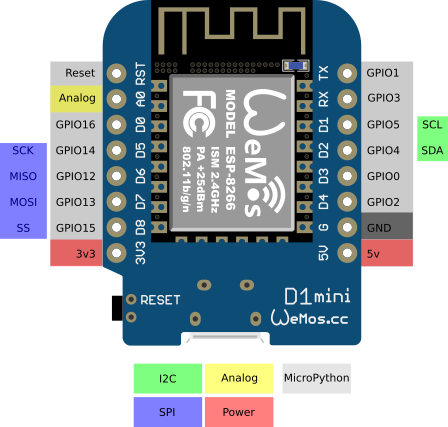Best pins to use on ESP8266

Most board do not have made all pins available. The NodeMCU boards have almost all usable pins made available and some which need special attention.
| GPIO | Input | Output | Remarks |
|---|---|---|---|
| 5 (D1) | OK | OK | Often used for I2C |
| 4 (D2) | OK | OK | Often used for I2C |
| 14 (D5) | OK | OK | |
| 12 (D6) | OK | OK | |
| 13 (D7) | OK | OK | |
| 0 (D3) | pulled up | OK | Boot fail if pulled low |
| 2 (D4) | pulled up | OK | Boot fail if pulled low |
| 15 (D8) | pulled to GND | OK | Boot fail if pulled high |
| 16 (D0) | High at boot, pull down to GNDno interrupt | no PWM / I2C support | Used to wake up from deep sleep |
| 9 (SD2) | High at boot | See notes | |
| 10 (SD3) | High at boot | See notes | |
| 3 (RX) | High at boot | is RX | RX channel of serial0 |
| 1 (TX) | is TX | debug output at boot | Boot fail if pulled low |
The labels used in the tabel above are the labels on NodeMCU boards.
Sources used:
- The Hook Up – How To: Pick the right pins on the NodeMCU ESP8266 and ESP32
- ESP8266 GPIO pin “features”
- Rabbithole – ESP8266 GPIO Behaviour at Boot
Special notes on GPIO 6 – 11
Almost any ESP8266 board has a flash chip connected to some or all of GPIO6-GPIO11.
GPIO 9 & 10 can be used on ESP8285, since that chip has 1 MB flash embedded and is not using those pins. One or both of pins may sometimes also be available on ESP8266 boards, depending on the flash used and the flash operation mode.
- Quad IO (QIO) uses 4 lines for data (6 pins total)
- Dual IO (DIO) uses 2 lines for data (4 pins total)
- Standard uses a single line for data (3 pins total)
It is best not to use any of the GPIO pins 6 – 11.
Special notes on GPIO 16
GPIO-16 is a special pin. The RTC will send a short (low) pulse when the sleep timer does send a wake-up signal.
In order to wake from deep sleep, GPIO-16 has to be connected to the RST pin. If connected, this pin should not be used as GPIO pin, or else the module will reboot.
Other limitations are:
- GPIO16 has a built-in pull-down resistor (all others have built-in pull-up)
- To enable the pull-down resistor for GPIO16, you have to use
INPUT_PULLDOWN_16